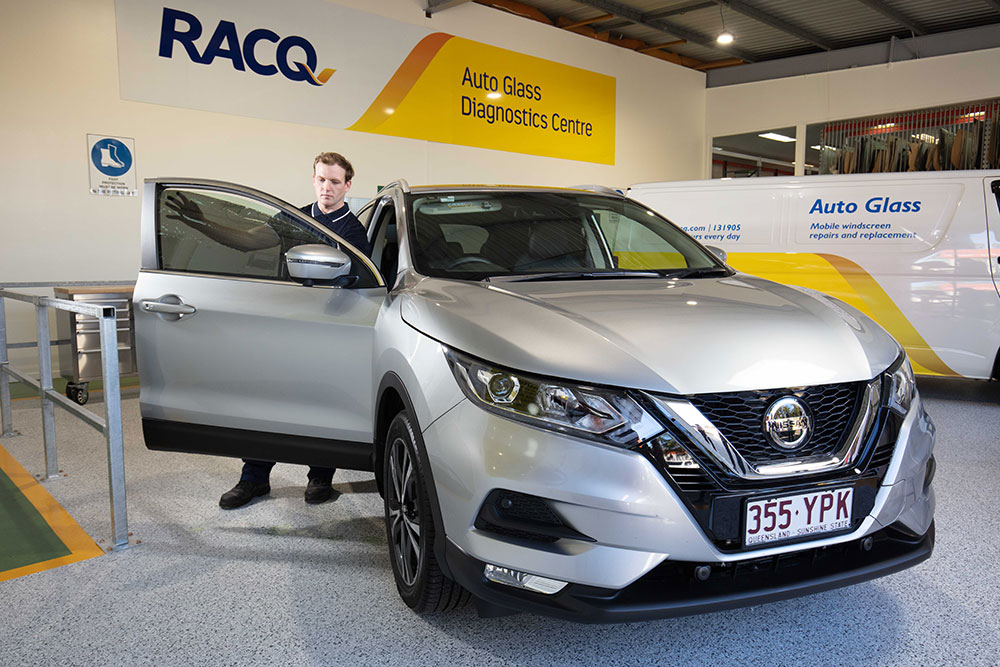Car window tints explained
Understand the different types of window tints before buying.

Tinted car windows not only look good, they also improve comfort and safety for vehicle occupants.
They can block out up to 99% of harmful UV rays, reduce the impacts of heat inside vehicles and cut annoying and potentially dangerous glare.
They also add to the vehicle’s safety as the tint’s film can hold together shattered glass in a crash.
RACQ Autoglass Window Tinter Brandon Wilson said films came in many shades, with the most popular in Queensland being the darkest legally allowed.
A tint film’s shade is measured as the percentage of light allowed to pass through the window, known as VLT or Visible Light Transference.
“A lower percentage VLT allows less light to pass through the car’s window and is therefore a darker film,” Brandon said.
Darkest legal tint in Queensland
The darkest legal window film for front door glasses is 35% in Queensland. However, you can go darker (20% VLT) in the car's rear section.
“The darker film for the rear section of the car is great for kids, pets or to protect the car’s interior as it offers higher heat rejection, glare rejection and privacy when compared with the darkest legal film for the front windows,” Brandon said.
He said it was important to know what you wanted from your tinting before choosing between the four options – dye, carbon, metallised and ceramic.
“If you are tinting your car mainly to enhance appearance and privacy, then dye and carbon films are an affordable option,” Brandon said.
“Although they don’t offer the heat rejection of metallised and ceramic films, most do provide 99% UV protection.
“If you are looking for maximum heat rejection and interior protection, then ceramic and metallised films are the best options.
“Metallised films are more affordable, but they are made of metal particles known to interfere with cellular and radio signals, which can be an issue.
“Ceramic films, however, are signal-friendly and tend to offer higher heat rejection, optical clarity, interior protection, and longevity.”
Brandon said the best ceramic films were nano-ceramic films which provide the highest heat rejection and clarity amongst all window film technologies.
“Once you’ve determined what range of films you are looking for, ensure the film you do select has a good warranty and the service provider is trusted,” he said.
Different types of window tint
- Dye films are great for people who are mainly looking to improve the aesthetic and privacy of their car.
They are often nice-looking films, but they provide less heat rejection than new technologies and won’t last as long.
The latest dye technology is called deep dye, which provides a colour-stable (won’t fade or change colour) warranty, unlike previous dye technologies that fade or turn purple over time.
- Carbon films are similar to dye films but offer the colour stability that old dye technologies are missing.
Downsides include potential haziness due to the size of the carbon particles used to construct the film being larger than newer technologies which allow light to bounce around, ultimately affecting its clarity.
- Metallised films can be a great way for people to get good heat-rejecting films for a lower price.
However, metals are known to interfere with radio and cellular signals. Also, they don’t offer the longevity of ceramic films.
- Ceramic films are made from particles that are non-conductive and non-metallic.
This makes them great for blocking heat and not interfering with radio and cellular signals. The best ceramic films are nano-ceramic films with the smallest and most uniform particle size, which provide the highest heat rejection and clarity amongst all window film technologies.
The heat from the sun can be broken into UV, visible light and infrared rejection. Older technologies mainly rely on rejecting UV and visible light.
Since they rely on blocking visible light, they offer good heat rejection at darker VLTs but not so much at higher VLTs. Ceramic films, however, block a large percentage of infrared radiation, which makes up about half of the heat you feel from the sun, unlike other technologies.
Infrared is non-visible light, so blocking large amounts of this has little impact on the VLT of films, allowing significantly more heat rejection at higher VLTs such as clear/light films, making a ceramic film the best option for privacy glass.
Drive in comfort and style with RACQ car window tinting
Related topics
Things to note
The information in this article has been prepared for general information purposes only and is not intended as legal advice or specific advice to any particular person. Any advice contained in the document is general advice, not intended as legal advice or professional advice and does not take into account any person’s particular circumstances. Before acting on anything based on this advice you should consider its appropriateness to you, having regard to your objectives and needs.
Insurance Products (excluding Travel Insurance) are issued by RACQ Insurance Limited ABN 50 009 704 152 (RACQI) and arranged by its agent, RACQ Distribution Services Pty Ltd (RDS) ABN 35 116 361 650, AFSL 567130 and RDS' authorised representatives (including RACQ Operations Pty Ltd ABN 80 009 663 414, AR No. 234978 (RACQO). Conditions, limits and exclusions apply. RDS and RACQO are in the RACQ group of companies. One of the companies in the RACQ group of companies has a minority shareholding in RACQI.
RDS and RACQO have not taken your personal objectives, circumstances or needs into account when preparing advice regarding insurance products and you will need to consider whether the advice is appropriate for you. Read the Product Disclosure Statement (PDS) and any applicable Supplementary PDS before making a purchase decision on this product. You can also access our Target Market Determinations on this website. RDS receives a commission from RACQI for the policies it arranges. RACQO receives fees paid for services it provides to RDS. Further details about remuneration are available on request prior to purchasing.
Banking and loan products issued by Members Banking Group Limited ABN 83 087 651 054 AFSL/Australian credit licence 241195 trading as RACQ Bank. Terms, conditions, fees, charges and lending policies apply. This is general advice only and may not be right for you. This information does not take your personal objectives, circumstances or needs into account. Read the disclosure documents for your selected product or service, including the Financial Services Guide and the Terms and Conditions, and consider if appropriate for you before deciding.
Except for RACQ Bank, any RACQ entity referred to on this page is not an authorised deposit-taking institution for the purposes of the Banking Act 1959 (Cth). That entity’s obligations do not represent deposits or other liabilities of RACQ Bank. RACQ Bank does not guarantee or otherwise provide assurance in respect of the obligations of that entity, unless noted otherwise.
RACQ Bank subscribes to the Customer Owned Banking Code of Practice which establishes higher standards than the law requires. The Code reflects modern consumer expectations and developments in approaches to issues such as consumer vulnerability, guarantors, and supporting customers through financial hardship. Please read our Customer Owned Banking Code of Practice page for more information.
RACQ Operations Pty Ltd (ABN 80 009 663 414 AR 000234978) and Members Travel Group Pty Ltd (ABN 45 144 538 803 AR 000432492) are acting as an Authorised Representative of the issuer of the insurance, Tokio Marine & Nichido Fire Insurance Co., Ltd. (ABN 80 000 438 291 AFSL 246 548). Any advice set out above is general in nature only, and does not take into account your objectives, financial situation or needs. Before purchasing any travel products, please consider the RACQ Travel Insurance Product Disclosure Statement (PDS) and the Target Market Determinations (TMDs) that apply to these products. Whilst the PDS outlines the Terms and Conditions of these products, the TMDs outline the intended class of customers that comprise the target market for these travel products. This will allow you to consider which products best suit your objectives, financial situation and needs and consider the products appropriateness to your personal circumstances. TMDs also outline matters involving the distribution and the review of these products. The PDS, Supplementary PDS and TMDs for each travel product can be found here.
